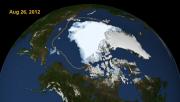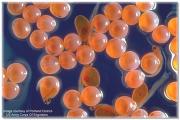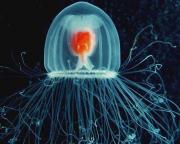Radio Program
Our regular Science and the SeaTM radio program presents marine science topics in an engaging two-minute story format. Our script writers gather ideas for the radio program from the University of Texas Marine Science Institute's researchers and from our very popular college class, Introduction to Oceanography, which we teach to hundreds of non-science majors at The University of Texas at Austin every year. Our radio programs are distributed at to commercial and public radio stations across the country.
The frogs that are found in most American back yards fill up on flies, mosquitoes, and other insects. But a frog that’s found in southeastern Asia goes after slightly bigger quarry – including small crabs.
The crab-eating frog isn’t some monster – it grows to only about three inches long. Even so, it’s not your average frog. In fact, it does something that no other frog can do: It can live in both fresh water and salt water.
Many people get their hair trimmed a little closer to help beat the summer heat. And the same thing happens to our planet – the north polar ice cap gets trimmed as the weather gets warmer. In recent years, though, it’s as though the barber’s been out of control, with the ice cap cut farther back each year.
Swimming in cool water may be invigorating for some, but for some tiny marine creatures it could be deadly. It’s tougher for small creatures to move through cold water than it is for larger creatures, making them easier prey. But at least some of the little guys have a way to compensate.
The Pacific Northwest may have its legends of Bigfoot, but the waters of the Arctic have a legendary creature of their own: a creature with a big tooth that may have helped inspire tales of unicorns.
At the start of the 20th century, hunters were killing so many pelicans for feathers that the birds were disappearing from Pelican Island, off the Atlantic coast of Florida. So a group of local businessmen and conservationists convinced President Teddy Roosevelt to do something about it. In March of 1903, Roosevelt established Pelican Island as a federal bird refuge. It was America’s first national wildlife refuge, as well as its first marine protected area — a section of land or water where human activities are limited.
As the oceans grow warmer, some species of fish change addresses. They leave waters that have grown too warm, or expand their range into waters that had been too cool for them. One way to follow these migrations is to toss a net in the water and see what species you come up with. Another is to count not the fish, but their eggs.
Juvenile glass eels aren’t the most appetizing critters around. They look like short, wiggly transparent noodles, and it takes thousands of them to fill a bucket. And then there’s their other name — elvers. Yet in recent years these tiny creatures have become some of the most expensive fish in American waters, fetching up to $2,000 a pound — and spawning a big increase in poaching.
Every year, large “dead zones” form in the Gulf of Mexico off the coasts of Texas and Louisiana. They form when river water loaded with fertilizer and other nutrients gushes into the Gulf. The nutrients spawn a massive “bloom” of microscopic organisms that use up much of the water’s oxygen. That kills fish and shellfish.
Stress can cut years from our lives. But for a tiny jellyfish-like organism, it’s just the opposite. Stress actually makes it age backwards — and eventually revert to its earliest stage of life. That provides a sort of immortality, as the organism produces a whole bunch of identical copies of itself.
The organism is known as Turritopsis. It was discovered in the 1880s in the Mediterranean Sea. Since then, it’s hitchhiked around the world in the ballast water of ships.
It’s hard to find a meat product these days that doesn’t have a soy-based equivalent — from burgers and chicken nuggets to bacon strips and chorizo. There aren’t a lot of soy substitutes for fish, though. But in the future it may not matter all that much, because many fish may be raised on a soy-based diet.





